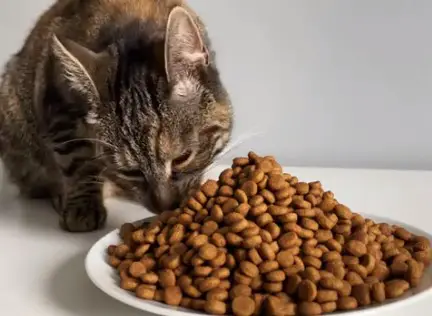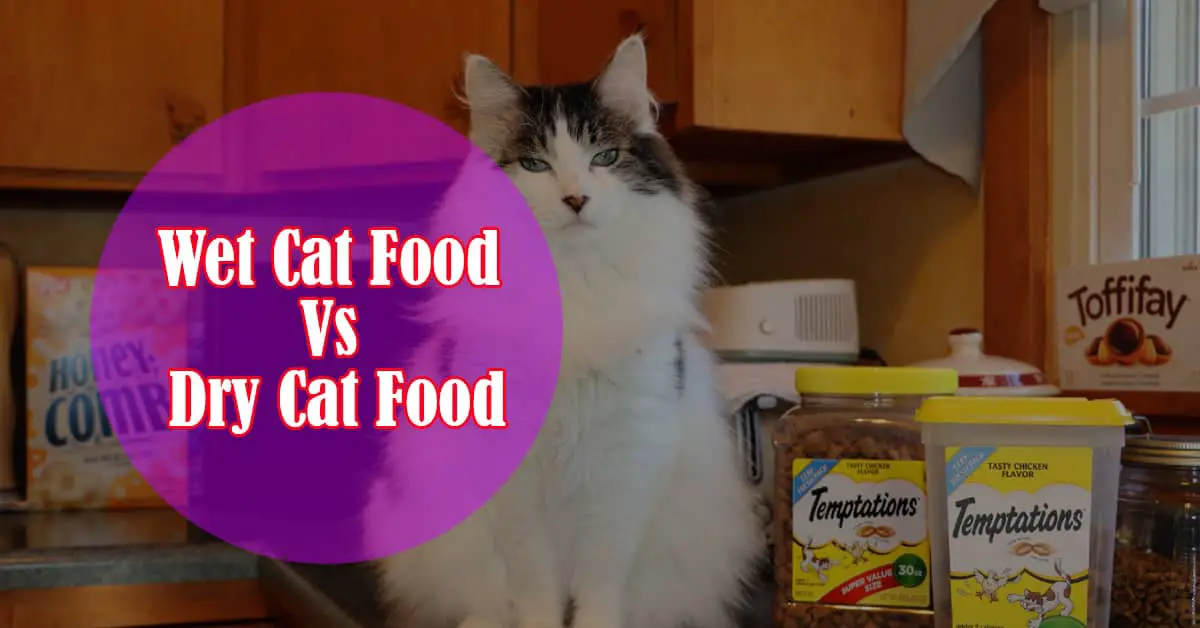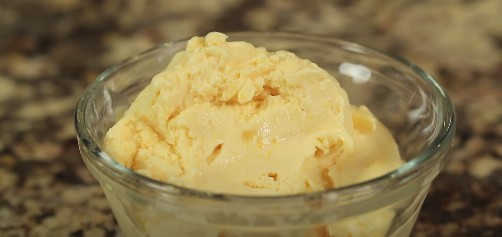Wet and dry cat food are both popular choices, but which one is better for your cat? The answer depends on your cat’s individual needs and preferences.
Finding the best cat food for your pet depends on these factors:
- Your cat’s weight (low, medium or high)
- Your cat’s present health condition (disease-free or not)
- Nutritional adequacy (complete vs. complimentary)
- Life stage
- Lifestyle
- And obviously your budget
What Nutrients Do Cats Need?
Before diving deep into the debate on wet vs dry cat food, let us first know what nutrients cats need. Cats are obligate carnivores, which means they need animal protein in their diet to survive.
They cannot make their own taurine, an amino acid that is essential for their health, so it must be provided in their food. Other important nutrients for cats include:
- Protein: Cats need a high-protein diet, with about 25% of their calories coming from protein. Protein is essential for building and maintaining muscle mass, as well as for other bodily functions such as organ health and wound healing.
- Fats: Fats are also an important part of a cat’s diet, providing energy, essential fatty acids, and fat-soluble vitamins. Cats need a balance of omega-3 and omega-6 fatty acids, which can help with skin and coat health, heart health, and cognitive function.
- Carbohydrates: Cats do not need a lot of carbohydrates in their diet, but some are necessary for energy. Good sources of carbohydrates for cats include whole grains, vegetables, and fruits.
- Water: Cats need plenty of fresh, clean water to stay hydrated. They should have access to water at all times.
- Vitamins and minerals: Cats need a variety of vitamins and minerals to stay healthy. Some of the most important vitamins and minerals for cats include Vitamin A, D, E, K, Thiamin, Riboflavin, Niacin, Pyridoxine, Biotin, Choline, etc.

Wet Food and Dry Food: Differences
Wet food and dry food are the two main types of cat food available. Both have their own pros and cons. Let’s see the differences between wet vs dry cat food:
Moisture Content
The main difference between dry and cat food is the amount of water the food contains. Water is an essential supplement for the cat’s body. Cats who don’t drink sufficient water may suffer from various disorders.
This might be important for you if your cat has certain health conditions and needs proper water intake.
Manufacturing Process
Wet cat foods are made by mixing fresh or frozen meats with a protein source from grains. The muscles are combined with water, fats and vitamins and placed in a can. Afterward, they are warmed up to destroy the foodborne pathogens.
Dry food is prepared by mixing and cooking meats, vegetables, minerals and fats at high pressure to make the starches more absorbable. Many manufacturers also spray fat over the food to ensure it’s palatable.
Hydration
In comparison, dry cat food typically contains only 6-10% water, while canned wet cat food boasts an impressive 75-78% water content. Consequently, cats consuming wet food derive a significant portion of their hydration from their diet, resembling a more natural source of moisture.
Nutrients
Typically, the amount of carbohydrates is more in dry cat food than wet cat food. However, the amount of protein and fats contained in dry and wet cat food can vary depending on the type of diet. Additionally, some dry foods may also contain probiotics.
Calorie density
Wet food has a lower calorie density than dry food. This means that cats need to eat more wet food to get the same number of calories. This can be helpful for cats who are overweight or obese.
Shelf life
Wet food has a shorter shelf life than dry food. This is because it is more perishable. Wet food should be stored in the refrigerator after opening and used within 3-5 days. Dry food can be stored at room temperature for up to 18 months.
Dental health
Dry food is better for dental health than wet food. This is because dry food helps to scrape plaque and tartar off of the teeth.
Ease of feeding
Wet food can be messier than dry food. This is because it can drip and spill. Dry food is less messy, but it can be more difficult to get cats to eat it.
Here is a table summarizing the key differences between wet food and dry food:
| Feature | Wet Food | Dry Food |
|---|---|---|
| Moisture content | 70-80% | 10-12% |
| Calorie density | Lower | Higher |
| Cost | More expensive | Less expensive |
| Dental health | Less beneficial | More beneficial |
| Palatability | Higher | Lower |
| Shelf life | Shorter | Longer |
| Ease of feeding | More messy | Less messy |
RELATED: Difference between Cat and Dog food
Wet vs Dry Cat Food: Pros and Cons
✅ Wet Cat Food Benefits
Wet food can eliminate the risk of kidney disease and avoid dehydration in cats. In addition, cats with certain health conditions that need more water intake than normal cats may benefit from the additional water in this diet.

Finally, wet cat foods provide some other major advantages like:
- Urinary Health: Wet foods are useful to prevent urinary tract problems. According to the hypothesis, wet food will promote more dilute urine, resulting in low inflammatory components in the urinary bladder. This is also effective in eliminating kidney disease risks as it ensures sufficient water is provided to the body. Kidney failure is caused in cats due to insufficient water intake. Therefore, make sure your cat is getting enough water.
- Weight Management: Wet food does not provide calories. As a result, wet food has a lower energy density than dry cat food. Wet foods provide 0.8–1.5 kcal/g, where typical dry food where dry foods provide 3–4 kcal/g or even higher.
- Constipation: As wet food has a higher moisture level than dry food, it does not cause dehydration. However, dehydration is a risk factor for creating constipation, so wet food can be beneficial in these cases.
Experts recommend feeding wet food to cats suffering from this problem.
❌ Disadvantages of wet cat food
Yes, wet food has several benefits, but it is more costly than dry cat food, a negative factor. Many cat parents prefer dry food over wet cat food considering the price.
Additionally, the wet cat food has a shelf life of 24 hours and must be stored in the refrigerator once opened. Therefore, if your cat does not finish their wet meal, it should be stored in the refrigerator or discarded.
Leaving cat food out for longer than a few hours might develop the risk of contamination.
✅ Dry Cat Food Benefits
Dry cat foods generally need a lower budget than wet cat food. So if you are buying food to feed community cats, dry food would be a better option.
Moreover, dry food does not have to be stored in the refrigerator and can be left out for a much longer period than wet food. Therefore, dry food can be a good option if you free-feed your cat. However, you should discard any portion not eaten by your cat at the end of the day.
Some other benefits we can achieve from dry food are:
- Cost: The first benefit of dry food is the cost. Millions of cats around the world are fed dry foods either exclusively or combined. Additionally, if your pet is left out for a long time, dry food allows free feeding.
- Oral Health: Some dry diets can prevent tartar formation or slow down plaque accumulation, mainly achieved by mechanical scraping teeth. But, again, not all dry foods promote dental health. To maintain the dental health of your cat, ensure your brush regularly.
- Energy Density: Dry foods have greater energy density than wet. This can be a problem for cats who cannot self-regulate their energy intake.
❌ Disadvantages of dry cat food
Studies have shown that there is a bridge between obesity and dry cat food. Because most of the dry foods are often free-fed and parents don’t realize how much their pets are eating a day. Obesity can lead to diabetes and other serious health issues.
Again, it can be the opposite, and you do not know how much your cat is eating or even if they are not eating at all. Monitor your cat’s amount of food intake daily. Avoid free-feeding to maintain a healthy diet.
Older cats with dental problems might find it hard to chew dry cat food.
Is It Better for Cats to Eat Wet or Dry Food? Or Both?
The choice between wet and dry cat food depends on various factors, and in many cases, a combination of both can provide a balanced diet that meets your cat’s specific needs.

Wet cat food offers high moisture content, aiding in hydration and appealing to picky eaters.
It can be advantageous for cats with urinary tract issues or those needing weight management.
Dry cat food, on the other hand, provides convenience and can assist in maintaining dental health.
It’s often more budget-friendly and can be left out for free-feeding. However, it tends to be less hydrating.
To strike the right balance, consider your cat’s age, health, and preferences, and consult with your veterinarian for tailored dietary recommendations.
My Cat Only Eats Dry Food, How to Make Sure She’s Getting Sufficient Water?
If your cat is on a dry diet, it is best to promote water intake to prevent urinary problems. A constant supply of fresh and clean water should always be available. Some other steps that can promote water intake are:
- Location of water bowls: Keep the water intake separate from litter and food bowl areas. Select a quiet, suitable place for the water station for your cat to drink without being disturbed.
- Choice of water bowl: Cats seem to prefer ceramic or steel bowls. Use a flat bowl since some cats don’t like their whiskers touching the water.
- Multiple drinking stations: In most cases, multiple water stations seem to increase the water intake of cats. Instead, place a water bowl at different corners of the house and allow your cat to drink freely.
- Install a water fountain: Some cats tend to drink from running water. That is why we often see them drinking tap water when it’s running. Install a water fountain to use as a good alternative in these cases. Make sure the water fountain is often cleaned and filtered as recommended by the manufacturer.
FAQ’s
Is wet or dry food better for my cat’s health?
Some cats prefer wet food, while others prefer dry food. Ultimately, it is up to the owner to decide what is best for their cat’s health.
There are benefits and drawbacks to both wet and dry food. Wet food generally contains more moisture, which can be beneficial for cats that are prone to dehydration.
Dry food, on the other hand, is typically higher in calories and may help cats maintain a healthy weight.
What is the water content of wet cat food?
The water content of wet cat food can vary depending on the recipe, but is typically around 78-80%.
Do cats need wet food every day?
No, cats do not need wet food every day. In fact, most cats will do just fine if they only eat wet food a few times a week. However, some cats may prefer to eat wet food more often, and there are a variety of wet foods available to cater to their preferences.
Can cats live on dry food only?
Cats can survive on a dry food diet, but it is not ideal for their health. Dry food is typically lower in moisture than wet food, which can lead to dehydration. Dehydration can cause serious health problems, including kidney disease.
Should cats eat both wet and dry food?
Most cats will eat both wet and dry food, although some may prefer one over the other. If you have a kitten, it’s best to feed them both wet and dry food to get them used to it.
Kittens need to eat more often than adult cats, so they may prefer wet food because it’s easier to eat small meals more often.
Adult cats can be more finicky, so you may have to experiment to see what they prefer. If your cat is overweight, you may want to feed them mostly dry food to help them lose weight.
How to Switch from Dry Cat Food to Wet Cat Food—Or Vice Versa
Switching a cat’s diet from dry to wet food, or vice versa, requires a gradual transition to prevent digestive upset. Start by mixing a small amount of the new food with the current one, increasing the proportion of the new food over a week or two. Monitor your cat’s response, as some may resist change.
Transitioning from dry to wet food can be easier, as cats are often drawn to the moisture and flavors of wet food. However, wet food can be costlier and less convenient due to its shorter shelf life.
Be mindful of your cat’s nutritional needs and consult your vet for guidance on making the switch safely and effectively.
Does Dry Food Clean Cats’ Teeth?
Dry cat food is often marketed as promoting dental health, but its effectiveness in cleaning a cat’s teeth is limited. While the abrasive texture may help remove some plaque, it’s not a substitute for proper dental care.
Regular toothbrushing and veterinary dental check-ups are crucial for maintaining your cat’s oral hygiene. Wet food can also contribute to dental health by reducing plaque buildup compared to exclusively feeding dry kibble.
What’s the Cost of Wet vs. Dry Cat Food?
When comparing prices per ounce, dry cat food usually offers better value than its wet counterpart. Additionally, the extended shelf life of kibble results in less food waste.
However, it’s important to consider the potential costs of veterinary visits resulting from an unsuitable diet that doesn’t account for your cat’s age, activity level, or medical background.
To ensure both your cat’s well-being and budget compatibility, consult your veterinarian for personalized dietary recommendations.
How can I combine wet and dry food in my cat’s diet?
Either by mixing both duets or giving wet food at a time and dry food at the other time, you may be able to achieve the benefits of both diets.
If you’re willing to mix the wet and dry food, talk with your veterinarian to find the best balance. Your veterinarian will be able to determine the right portion of the two diets according to your cat’s present condition.
Remember, every cat is different and the amount of food you feed to every cat is different. Feeding manually when your cat is hungry is a lot better than free-feeding unless you have a busy schedule.
Conclusion
Dry and wet cat food each have pros and cons. Dry food is calorie-dense, suitable for active cats, and can be used for enrichment. Wet food is more hydrating but slightly pricier. If your cat doesn’t drink enough water, wet food is a better choice to avoid health issues from prolonged dry food consumption.
Now you know the answer to “wet vs dry cat food”! Want to find out more about wet or dry food better for cat weight loss? Why my cat is obsessed with food? next.
His professional interests include humane education, ethics, small animal behavior, and veterinary. As a pet lover from school life, having grown up with two cats and a dog. If he isn’t spending time with his friends and family, Justin enjoys traveling. Learn more about Justin here.


